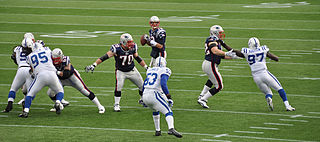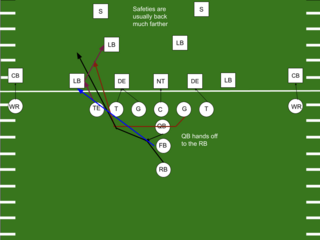
In gridiron football, a lineman is a player who specializes in play at the line of scrimmage. The linemen of the team currently in possession of the ball are the offensive line, while linemen on the opposing team are the defensive line. A number of NFL rules specifically address restrictions and requirements for the offensive line, whose job is to help protect the quarterback from getting sacked for a loss, or worse, fumbling. The defensive line is covered by the same rules that apply to all defensive players. Linemen are usually the largest players on the field in both height and weight, since their positions usually require less running and more strength than skill positions.

Linebacker (LB) is a playing position in gridiron football. Linebackers are members of the defensive team, and line up three to five yards behind the line of scrimmage and the defensive linemen. They are the "middle ground" of defenders, playing closer to the line of scrimmage than the defensive backs (secondary), but farther back than the defensive linemen.

The tight end (TE) is an offensive position in American football, arena football, and Canadian football. It is a hybrid that combines the characteristics and roles of both an offensive lineman and a receiver. As part of the receiver corps, they play inside the flanks (tight), contrasted with the split end who plays outside the flanks (wide). Like offensive linemen, they are usually lined up on the offensive line and are large enough to be effective blockers. On the other hand, unlike offensive linemen, they are eligible receivers and potent weapons in a team's offensive schemes.
A draw play, or simply draw for short, is a type of American football play. The draw is a running play disguised as a passing play. It is the opposite of a play-action pass, which is a passing play disguised as a running play. The play is often used in long yardage situations.
In gridiron football, blitzing is a tactic used by the defense to disrupt pass attempts by the offense. During a blitz, a higher than usual number of defensive players will rush the opposing quarterback, in an attempt either to tackle them or force them to hurry their pass attempt.
Strategy forms a major part of American football.

In American football, blocking or interference involves legal movements in which one player uses his body to obstruct another player's path. The purpose of blocking is to prevent defensive players from tackling the ball carrier, or to protect a quarterback who is attempting to pass, hand off or run the ball. Offensive linemen and fullbacks tend to do the most blocking, although wide receivers are often asked to help block on running plays and halfbacks may be asked to help block on passing plays, while tight ends perform pass blocking and run blocking if they are not running routes to receive passes. Overall, blocking is a skill that virtually every football player may be required to do at some point, even defensive players in the event of a turnover.

A sweep is an outside running play in American football where a running back takes a pitch or handoff from the quarterback and starts running parallel to the line of scrimmage, allowing for the offensive linemen and fullback to get in front of him to block defenders before he turns upfield. The play is run farther outside than an off tackle play. Variants of the sweep involve the quarterback or a wide receiver running with the ball, rather than a running back. When a wide receiver runs with the ball, it is known as a jet sweep.

The passing pocket, or the pocket, is a term used in American football to describe the area in the backfield created on a passing play where the offensive line forms a wall of protection around the quarterback. This allows him adequate time to find an open receiver and to pass the ball. The offensive line will drop back slightly, creating a U-shaped protected area for the quarterback to find an open receiver and pass the ball.
The zone run in American football is a running play based on zone blocking.

A halfback (HB) is an offensive position in American football, whose duties involve lining up in the offensive backfield and carrying the ball on most rushing plays, i.e. a running back. When the principal ball carrier lines up deep in the backfield, and especially when that player is placed behind another player (usually a blocking back), as in the I formation, that player is instead referred to as a tailback (TB).

In American football, the specific role that a player takes on the field is referred to as their "position". Under the modern rules of American football, both teams are allowed 11 players on the field at one time and have "unlimited free substitutions", meaning that they may change any number of players during any "dead ball" situation. This has resulted in the development of three task-specific "platoons" of players within any single team: the offense, the defense, and the so-called 'special teams'. Within these three separate "platoons", various positions exist depending on the jobs that the players are doing.

The triple option is an American football play used to offer six ways to move the football forward on the field of play. The triple option is based on the option run, but uses three players who might run with the ball instead of the two used in a standard option run.
In American football, a play is a close-to-the-ground plan of action or strategy used to move the ball down the field. A play begins at either the snap from the center or at kickoff. Most commonly, plays occur at the snap during a down. These plays range from basic to very intricate. Football players keep a record of these plays in a playbook.

In American football, a power run is a running play used out of a variety of offensive formations using two backs.

In American football, a 4–3 defense is a defensive alignment consisting of four down linemen and three linebackers. It is called a "base defense" because it is the default defensive alignment used on "base downs". However, defenses will readily switch to other defensive alignments as circumstances change. Alternatively, some defenses use a 3–4 defense.
The following terms are used in American football, both conventional and indoor. Some of these terms are also in use in Canadian football; for a list of terms unique to that code, see Glossary of Canadian football.
In American football, a smashmouth offense is an offensive system that relies on a strong running game, where most of the plays run by the offense are handoffs to the fullback or tailback. It is a more traditional style of offense that often results in a higher time of possession by running the ball heavily. So-called "smash-mouth football" is often run out of the I-formation or wishbone formation, with tight ends and receivers used as blockers. Though the offense is run-oriented, pass opportunities can develop as defenses play close to the line. Play-action can be very effective for a run-oriented team.
The Packers sweep, also known as the Lombardi sweep, is an American football play popularized by Green Bay Packers coach Vince Lombardi. The Packers sweep is based on the sweep, a football play that involves a back taking a handoff and running parallel to the line of scrimmage before turning upfield behind lead blockers. The play became noteworthy due to its extensive use by the Packers in the 1960s, when the team won five National Football League (NFL) Championships, as well as the first two Super Bowls. Lombardi used the play as the foundation on which the rest of the team's offensive game plan was built. The dominance of the play, as well as the sustained success of Lombardi's teams in the 1960s, solidified the Packers sweep's reputation as one of the most famous football plays in history.











